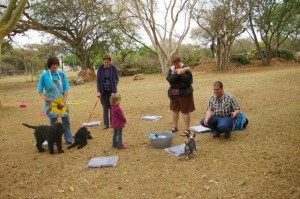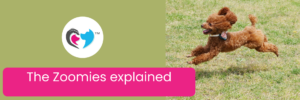Training a puppy is very much an activity for the whole family. We see a lot of clients who are living with a partner and/or have children in the house, but they come to class all alone. Sometimes, months later, their partner voices their concern that the dog only seems to listen to the person who brought them to puppy school. So what’s going on here?
Dogs are held up as the universal symbol of unconditional loyalty, but the fact is that owners need to build a relationship with their new puppy – it doesn’t just happen spontaneously. This is one of the big reasons why we use positive reinforcement training at ThinkingPets schools; it helps to build a relationship of trust. Clicker training in particular teaches the puppy that he won’t get punished for ‘getting it wrong’. He is encouraged to keep trying his best, and who could ask for more than that?
 These types of training methods also help the puppy to learn what behaviour his new owner expects of him. Remember that for a dog there is no such thing as right or wrong – there is only behaviour that feels good / gets rewarded and behaviour that doesn’t. By working diligently with your puppy using positive reinforcement, your pup gets to know you and the rules of the house. Each time you reward him for doing something you want, he learns which behaviours you prefer more and more. For example, if you only reward your puppy by greeting him after a long day at work when he sits, he learns that this is the way to get your attention.
These types of training methods also help the puppy to learn what behaviour his new owner expects of him. Remember that for a dog there is no such thing as right or wrong – there is only behaviour that feels good / gets rewarded and behaviour that doesn’t. By working diligently with your puppy using positive reinforcement, your pup gets to know you and the rules of the house. Each time you reward him for doing something you want, he learns which behaviours you prefer more and more. For example, if you only reward your puppy by greeting him after a long day at work when he sits, he learns that this is the way to get your attention.
On the other hand, if you only pay attention to him (even if it is just to scold) when he jumps up, he learns that this is the way to get your attention. So if we think of training as the way you and your puppy get to know each other, it stands to reason that the puppy will learn more about the person taking him to the Puppy Class. Puppy Class isn’t just about learning; it’s also about quality time spent with your pup. Your puppy learns to trust you and work with you. Other members of the household might interact with the puppy now and then, or even bring him his food every night. But how much quality, one-on-one time do they spend with the puppy? The puppy needs to learn to trust and work with each member of the family.Another aspect to look at is the fact that dogs just don’t generalize well.
We say this to our clients a lot. Just because Fifi knows how to sit on command in class outside on the grass, doesn’t mean she knows how to sit on command at home on the carpet. That is why we encourage clients to practice the behaviour learnt in class that week in as many places as possible. All this helps the dog to learn that “sit” means “sit”, no matter where you are! In this same way, if the puppy only ever trains with one person, she learns to only “sit” when that person asks. Each person will say a command differently (tone of voice, enunciation, etc.) and each person’s body language will also differ while giving the command.
A vital part of training that sometimes gets overlooked is having each member of the family practice the different tricks and behaviours with the puppy, in different locations. It isn’t always possible for all members of the family to come to a Puppy Class, keeping in mind everyone’s different work schedules. A remedy for this is for the other members of the family to practice that week’s lesson with the puppy at home or maybe in the park. Put in that extra 30min every other day and not only will your puppy learn, but you will help her to build relationship with each member of the family.

Keep in mind that all this doesn’t just pertain to behaviours like “sit” and “down”. Your puppy needs to learn to walk on a loose leash, come when called and give/swap objects when asked by any member of your household. Sometimes little things get overlooked, and Dad can’t understand why Fido tries to pull him off his feet in the park while he is perfectly capable of walking sedately next to Mom.When it comes to children, some discretion must be used. It is important for the new puppy to learn about children and to know how to work with children. Most schools encourage owners to bring their children to puppy class, provided that they are supervised, because it gives puppies in the class who are not in households with children the opportunity to interact with them appropriately and under supervision. However, certain exercises are best taught by parents first.
For example, it is best for the parents to teach the new puppy things like bite inhibition and not to jump up. Children tend to scream and squeal, and this might only excite the puppy even more – resulting in the puppy biting harder or jumping up more, instead of the opposite. Children are also not physically able to help teach a puppy about loose lead walking, as part of this training involves having to stand absolutely still and not moving when the puppy pulls. But they can help with other things such as sit, down, paw, etc., provided that an adult is there to help them and to teach them not to yank the treat away from the puppy (as this encourages the pup to grab food). Please do remember that a small child should never be left unsupervised with a dog. A parent or guardian should always be present to show the child how to play without pinching or hurting the dog.
So make training a fun activity for your whole family. Everyone can get a chance to work with the new puppy, as long as everyone teaches the puppy the same rules and hand signals / voice cues. Above all, enjoy the new member of your family!
Image Credits: Luke Ma via Flickr & Alta Massyn





